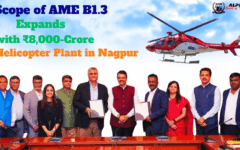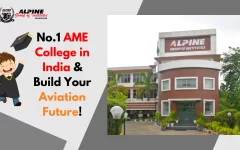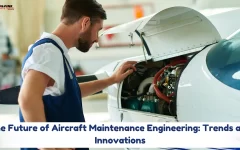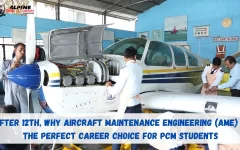Scope of Aircraft Maintenance Engineering (AME) in India: Opportunities, Growth Trends, and Career Prospects in 2025 and Beyond
2025-07-30 12:18Scope of Aircraft Maintenance Engineering (AME) in India: Opportunities, Growth Trends, and Career Prospects in 2025 and Beyond
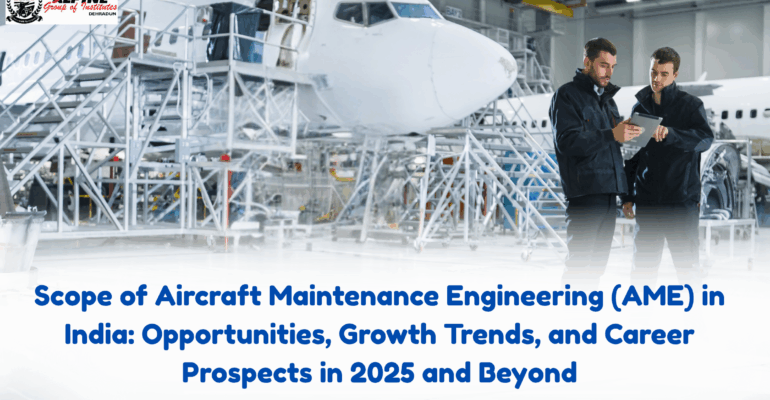
Scope of Aircraft Maintenance Engineering (AME) in India: Opportunities, Growth Trends, and Career Prospects in 2025 and Beyond
What is Aircraft Maintenance Engineering (AME)?
- Aircraft Maintenance Engineering is a specialized, licensing‑based program regulated by DGCA (India).
- Students train in Mechanical (B1.1 – aeroplane turbine) or Avionics (B2) streams. The typical course includes 2 years of academic training + 2 years of hands‑on practice on live aircraft at DGCA‑approved institutes.
- Entry requirement: 10+2 with Physics, Chemistry, Math (PCM) and physical fitness per DGCA norms.
Why is the AME Career in Demand?
Rapid Aviation Growth
- India is currently the world’s 3rd largest domestic aviation market and expects several thousand new aircraft by 2030 ➝ rising need for licensed AMEs.
- The domestic MRO (Maintenance, Repair & Overhaul) market is growing fast; projected at ~$4.3 billion by 2025 and forecasted to triple by FY 2028.
- Global aerospace firms (e.g. Airbus, Boeing, Rolls‑Royce) are increasingly sourcing parts and services from India, boosting local AME demand.
Infrastructure Expansion
- Projects like HAL’s Nashik MRO, IndiGo’s ₹1,100 crore Bengaluru MRO, and proposals for Airbus maintenance bases in Andhra Pradesh reflect expanding MRO capacity and job creation.
Regulatory & Training Evolution
- The new Bharatiya Vayuyan Adhiniyam, 2024, effective from Jan 1 2025, modernizes aircraft regulation in India—including maintenance licensures and training frameworks.
- DGCA continues issuing approvals for institutes and licensing AMEs, and initiatives like Skill India are expanding vocational training pipelines.
Career Opportunities & Job Roles
In India
- Airlines: Flight-line and base maintenance roles with carriers like IndiGo, Air India, Vistara, SpiceJet, GoAir, AirAsia India, and others.
- MRO Firms: Including Air Works, AIESL, HAL divisions, Cochin Intl Aviation, Eaton Aerospace, local startups—handling airframe, engine, component overhauls, line checks.
- Aircraft & Parts Manufacturers: HAL, Tata Advanced Systems, Airbus/Boeing suppliers, component makers involved in repairs and tech engineering.
- Regulatory & Safety Roles: With DGCA, safety inspectors, quality assurance, and aviation authorities ensuring compliance and safety certifications.
- Training & Academia: Positions at AME training institutes, technical colleges, and skill development centres.
Global Opportunities
- DGCA/EASA licences are recognized internationally. Indian‑trained AMEs work in Middle East, Europe, ASEAN, North America, and Africa.
- Global shortage of licensed AMEs—DGCA cites a demand for 754,000+ AMEs globally—creating high mobility potential.
Advanced & Emerging Roles
- Specializations: Quality Control, Avionics, Engine Overhaul, Technical Supervision, Safety Audits, R&D, UAV/eVTOL maintenance, predictive maintenance analytics.
- Career Ladder: AMEs can become Technical Managers, Maintenance Supervisors, Training Instructors, Safety Inspectors, or even aircraft design engineers with further qualifications.
Salary & Growth Outlook
- Entry-level in India: ₹3 LPA to ₹7 LPA (depending on institute, license, and location) .
- Mid‑level (3–5 years): ₹7–15 LPA; Senior/Specialist roles: ₹15–25 LPA, with top managers earning ₹30–50 LPA+.
- Abroad: AMEs can command starting salaries of US $45,000–65,000, with experienced engineers earning up to $100,000‑120,000+ annually.
Why Now is the Right Time
- Expanding fleet and new airlines + UDAN regional connectivity initiatives mean more demand for aircraft maintenance engineers.
- Infrastructure growth (new MRO facilities in Bengaluru, Nashik, Andhra Pradesh) creates thousands of jobs for AMEs.
- Policy momentum: Skill India, Make in India, new aviation laws, and incentives for domestic MRO expansion are strengthening the ecosystem.
- Technology & Innovation: Electric/hybrid aircraft, AI diagnostics, predictive maintenance, drone systems are reshaping the skillset—making AMEs future-ready.
Quick FAQ Summary
| Question | Answer |
| Course Duration & Eligibility | 4‑year DGCA‑approved AME (2 yrs academic + 2 yrs practical), 10+2 with PCM + medical fitness |
| License | DGCA Part‑66; EASA licenses are available for international jobs |
| Where to work | Airlines, MROs, OEMs, aviation training, regulators, global employers |
| Salary range | ₹3–7 LPA entry, ₹7–15 LPA mid, ₹15–50 LPA+ senior; higher abroad |
| Future tech areas | Avionics, predictive maintenance, electric aircraft systems, AI tools, UAVs |
Final Words
The Aircraft Maintenance Engineering field in India is robust, well‑paid, globally recognized, and future‑oriented. With aviation booming, regulatory reforms, expanding MRO infrastructure, and emerging technologies, AME is a future‑proof and high‑growth career path. Whether you’re interested in technical depth, training, safety regulation, or international roles—there’s a clear path to advancement.



